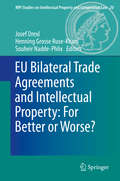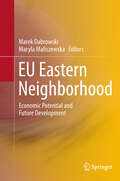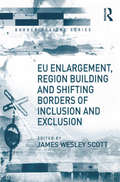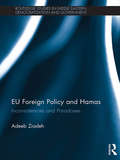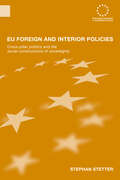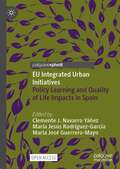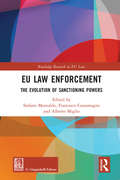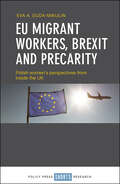- Table View
- List View
EPS15 Rajya Rooprekhaa Baanglaadesh - IGNOU
by IgnouPoltical Science Text Book for students of IGNOU
EPS15 Rajya Ruprekha Shri Lanka, Maldeev - IGNOU
by IgnouPolitical scicence Text Book for the students of IGNOU
EPS15 Rajya Ruprekhaa Pakistaan (3)- IGNOU
by IgnouPoltical Science Text Book for students of IGNOU
EQUITY IN COVID-19: Mitigation and Policy Responses in Africa (EADI Global Development Series)
by Dzodzi Tsikata Anika Altaf Gertrude Dzifa Torvikey Marleen DekkerThis Open Access edited volume presents twelve African case studies that systematically reconstruct, document and analyse how national governments and other stakeholders took equity into account in their initial policy responses to the COVID-19 pandemic. At the onset of the pandemic, many African governments acted quickly to suppress the virus through various public health measures, including lockdowns, mobilizing healthcare resources and designing responses to support the economy and the population. There were, however, significant variations in the severity and type of measures taken, as well as their accessibility and impacts. Equity was not a given and, therefore, important questions have been raised about who benefitted and who were left unprotected from the interventions, particularly those designed to protect income and basic services? The book, based on a variety of empirical data and disciplinary perspectives of research teams from across the continent, examines the inclusivity of mitigation and policy responses. It situates these findings on short-term interventions and impact in debates about the longer-term implications of the COVID-19 pandemic on the development of the African continent and proposes new directions for policy, research and practice in responses and interventions during crises.
ESO14 Bhartiya Samaj me Jaati ki Vyakhya - IGNOU
by IgnouIn this section it highlighted about various of religion Indian societies.
ESO14 Bhartiya Samaj me Varg - IGNOU
by IgnouIn this section 7 we know the thinking of different category of Indian Societies. In this section there are four units and every units describe the different category.
ESO14 Jaatiya Strikaran - IGNOU
by IgnouIn this section after reading we would know about ethnicity of every ethnic group is important in their life. This section is also described in four sections.
ESO14 Samajik Strikaran ka Parichay - IGNOU
by IgnouIn the first curriculum it has been introduce about society and social stratification. The aspect of various important ideas of social stratification and basic fundamentals and social sex thinking and social gender(Gender) and understand the implications ethnicity have tried many innovative.
ESO14 Samajik Strikaran ka Varnan - IGNOU
by IgnouThis section is described into four units in it some new ideas about social stratification will get to read. The idea of Marx and weber social classical ideas by own method to be presented.
ESO14 Samajik Vibhedan Aur Jaatiyata - IGNOU
by IgnouIn this section it is though about question of accompanied resolution of social gender. In this section it is discussed about the different social gender it is important in their society.
ESO14 Upekshit Samudaye aur Strikaran - IGNOU
by IgnouIn this section we will teach about social stratifications and neglected community.
ESPN: The Making of a Sports Media Empire
by Travis VoganOnce a shoestring operation built on plywood sets and Australian rules football, ESPN has evolved into a media colossus. A genius for cross-promotion and its near-mystical rapport with its viewers empower the network to set agendas and create superstars, to curate sports history even as it mainstreams the latest cultural trends. Travis Vogan teams archival research and interviews with an all-star cast to pen the definitive account of how ESPN turned X's and O's into billions of $$$. Vogan's institutional and cultural history focuses on the network since 1998, the year it launched a high-motor effort to craft its brand and grow audiences across media platforms. As he shows, innovative properties like SportsCentury, ESPN The Magazine , and 30 for 30 built the network's cultural caché. This credibility, in turn, propelled ESPN's transformation into an entity that lapped its run-of-the-mill competitors and helped fulfill its self-proclaimed status as the "Worldwide Leader in Sports." Ambitious and long overdue, ESPN: The Making of a Sports Media Empire offers an inside look at how the network changed an industry and reshaped the very way we live as sports fans.
ESSENCE The Obamas: The White House Years
by The Editors of EssenceESSENCE has followed the journey of this first family since long before they entered the national spotlight. President Barack Obama and his wife, Michelle Obama, became America's first African-American president and First Lady. This uplifting, beautifully illustrated 96-page salute to the Obamas commemorates their time in the White House and celebrates their significant moments. Among the highlights:The growth of Sasha and Malia from children into elegant young ladiesBe Fearless: an essay from the First Lady herself on her keys to successLavish and intimate photography showcasing the special moments of the Obama presidencyThe full text of President Obama's powerful and important eulogy in South Carolina of the Honorable Reverend Clementa C. Pinckney.
ESTADIO OBRAS (EBOOK)
by Gloria I. GuerreroMientras la Comisión Interamericana de Derechos Humanos de la OEA llegaba a la Argentina y se encontraba con la sarcástica campaña #Somos derechos y humanos#, la plata dulce y el #deme dos# de Martínez de Hoz iban a la par de una inflación galopante y la represión resultaba insostenible, el rock argentino agradecía la inesperada bendición de un nuevo estadio en Núñez. Por fin había un lugar donde reunirse. Y de a miles. Era una cancha de básquet, sí, pero terminó siendo un escenario que trascendió sus dimensiones físicas: se convirtió en mito. El Estadio Obras se inauguró a fines de 1978 y durante 31 años fue el Templo, nuestra casa. El rock caminó sus pasillos, y descansó y bebió en sus camarines. De Seru Giran a Soda Stereo, de los Redondos a Spinetta, de Sumo a Divididos, Gieco o Calamaro: el Primer Obras de un artista significó, siempre, infinitamente más que un concierto. Gloria Guerrero reconstruye la vida de este Templo con mano de orfebre y corazón de protagonista, contándola desde adentro. Músicos, empleados, fans, todos colaboran para crear un fresco increíble que retrata la historia del rock en la Argentina como nadie lo había logrado hasta ahora. Porque eso fue Obras: el lugar donde el rock se convertía en Historia. Ni más ni menos.
ETHICS: Cross-disciplinary Strategies (Designing Environments)
by Alessandra Battisti Serena BaianiThis book outlines, within the Italian national framework, the current and potential paths oriented towards a new concept of Architectural Heritage, through actions referring to Innovation and Experimentation and Protection and Transformation of the Architectural Heritage. The development of the themes is articulated in two sessions dealing with the aspects related to the analysis and mapping of Architectural Heritage to face the context of the current Climate Crisis and the development of projects and experimentations oriented to the Green and Digital Transition. The evolution of the concept of Heritage, as conceived by the United Nations 2030 Agenda and in the Green Deal and New European Bauhaus, aimed at constructing an inclusive and universally recognised definition to support supranational objectives of sustainable human development, gives rise to innovative strategies, methodologies and technologies that—in a direction of mitigation, contrast and adaptation to climate change—allow for the safeguard, renewed management and a hope for valorisation of Heritage on a national scale. In this direction, the understanding of Architectural Heritage as a 'non-renewable resource' determines the need to activate design experimentation laboratories oriented towards regeneration, articulated and complex, which require, in order to respond to the challenges posed by our era, a sensitive and dialogic multidisciplinary vision of a holistic type. In fact, on the one hand, it is necessary to redefine the usability and management methods of built heritage through the adoption of digital, mobility, energy, ecological, social, green and blue infrastructures; on the other hand, it is necessary to introduce new qualitative and quantitative parameters and performance indicators, adequate to verify the validity of the implemented strategies in a perspective of adaptation to climate change, able to clarify contents, processes and tools to contrast future risks. The pursuit of these objectives refers to the innovation of training paths, professionalising procedures, administrative regulations, and public policies that involve citizens and the private partnership towards a different project qualification and empowerment of stakeholders, inhabitants, professionals, and clients. The Technological Project makes it possible to activate different interventions aimed at acting, in an integrated manner, on assets, context and communities, according to an approach that reinterprets them on a common score, as proposed by the European Next Generation programme in three priority aspects: digitalisation and innovation, environmental transition, increased resilience and social sustainability of national economies. In this scenario, the interventions aimed at outlining sustainable development actions will have to place these concepts at the centre in a harmonious vision that starts from the recognition and enhancement of the Architectural Heritage, recognising it as a fundamental asset of the territories.
EU Bilateral Trade Agreements and Intellectual Property: For Better or Worse?
by Josef Drexl Henning Grosse Ruse - Khan Souheir Nadde-Phlix This book focuses on a new generation of bilateral and regional agreements negotiated by the EU with developing countries and which include intellectual property (IP) provisions setting standards exceeding those of the TRIPS Agreement. The contributions critically analyse the IP standards found in these agreements; their potential for reforming the international IP system; the implications for the multilateral IP system and other areas of international law such as human rights; and the often neglected topic of implementing the IP obligations in these agreements.
EU Eastern Neighborhood: Economic Potential and Future Development
by Maryla Maliszewska Marek DabrowskiThe selected papers in this volume were prepared under the research project on "EU Eastern Neighborhood: Economic Potential and Future Development (ENEPO)" funded by the EU Sixth Framework Program. They discuss the broad spectrum of development issues in the EU Eastern Neighborhood and economic relations between the enlarged EU and its Eastern neighbors in the former USSR. Individual chapters address areas of economic and social development, trade, energy, investment, migration, costs and benefits of economic reforms, development assistance and political economy of policy reforms. In particular, they examine interrelations and mutual synergies between trade liberalization, inflow of foreign investment, economic and institutional reforms and a reduction of income and development disparities. The publication thus closes an important knowledge gap in respect to the economic, social and institutional development of the CIS region and its economic relations with the EU.
EU Enlargement, Region Building and Shifting Borders of Inclusion and Exclusion (Border Regions Series)
by James Wesley ScottThe 2004 entry of 10 Central and Eastern European countries, along with Malta and Cyprus, into the EU has caused a huge shift in the EU's external boundaries. The socio-economic and political transformations that this shift has caused not only suggest new regional development opportunities, but also many potential problems and tensions. While the EU insists that enlargement will not signify 'new divisions', processes of inclusion and exclusion and the imposition of visa restrictions on non-EU citizens could pose obstacles to co-operation, conjuring fears of an emerging 'fortress Europe' that effectively divides the continent. Illustrated with case studies from Central and Eastern European border areas, this book examines capacities for region building across national borders in within the context of EU enlargement, synthesizing the various insights provided by local information and suggesting ways forward for the future development of the EU's 'Wider Europe' strategy.
EU Foreign Policy and Hamas: Inconsistencies and Paradoxes (Routledge Studies in Middle Eastern Democratization and Government)
by Adeeb ZiadehShortly after the overwhelming victory of Hamas in the 2006 parliamentary and municipal elections, civil war broke out in the Gaza Strip between members of the two factions, Hamas and Fatah. The EU, along with the US, UN and Russia, not only gave its support to Fatah against Hamas, but also imposed a tough siege on the Hamas government in an attempt to force it to accept the Quartet’s political conditions, described by Hamas leaders as unfair and impossible. Many observers are convinced that the EU’s behaviour in this matter has been unreasonable and has conflicted with the EU’s own democratic beliefs and values. This book sheds light on the EU’s policies in Palestine mainly from 2003- 2013, and provides a thorough examination of the inconsistencies and paradoxes in the EU discourse towards Hamas, and the determinants underlying such contradictions. It explores the reasons behind the EU labelling the Hamas a terrorist organization and discusses why the EU has boycotted its democratically elected body since 2006. Significantly, the book looks at whether the EU jeopardized its reputation and contravened its core normative values and objectives (democracy promotion, human rights, the rule of law and fundamental freedoms) by such a categorisation of Hamas. Exploring the EU’s policy towards Hamas is vital for understanding how the relationship between the EU and the rest of the Islamists in the Middle East is perceived, as it enables both sides to have a cognitive basis upon which to construct better relations. This book, based upon a vast spread of primary EU documents and interviews, will therefore be a valuable resource for those studying the Arab Israeli conflict, Political Islamic movements, the Middle East Peace Process, and anyone with an interest in European Union Foreign Policy.
EU Foreign and Interior Policies: Cross-Pillar Politics and the Social Construction of Sovereignty (Routledge Advances in European Politics)
by Stephen StetterThis book offers an innovative theoretical and empirical analysis of integration in EU foreign and interior policies across the three pillars, from the Maastricht Treaty to the Treaty of Nice. The establishment of the three pillar structure with the Maastricht Treaty has been one of the key transformations of European governance. This divided EU policies into three main areas: European Community, Common Foreign and Security Policy (CFSP) and Justice and Home Affairs (JHA) and for the first time the two sovereignty related areas of foreign and interior policies became part of the formal governance structure of the EU. This is the first volume to present a comparative perspective on how integration in both areas across the three pillars has contributed to the construction of a distinct sovereignty dimension of the EU. Drawing from sociological institutionalism and on the basis of the two case studies of EU Middle East and migration policies, it offers a comprehensive empirical analysis of cross-pillar policy-making dynamics in foreign and interior policies in the EU. EU Foreign and Interior Policies will appeal to scholars and researchers interested in international relations, European Union politics and Middle East studies.
EU Integrated Urban Initiatives: Policy Learning and Quality of Life Impacts in Spain
by Clemente J. Navarro Yáñez María Jesús Rodríguez-García María José Guerrero-MayoThis open access book presents a unique interdiscplinary analysis of urban projects promoted by the EU from a comparative perspective This book presents cross-sectional and cross-time analyses at the territorial level targeted by these initiatives focusing on the design, theory and impacts of urban projects developed under the framework of initiatives promoted by the European Union. The book includes a new methodology to analyse the design and theory of urban plans (the comparative urban portfolio analysis) and quasi-experimental strategies to perform impact assessment at the neighbourhood level (the territorial target of those initiatives). Although empirical analyses focus on examples in Spain, the resulting analytical and methodological outcomes of these studies can be applied in a broader context to analyse integral urban policies in other countries.
EU Law Enforcement: The Evolution of Sanctioning Powers (Routledge Research in EU Law)
by Stefano MontaldoThe existence of a structured enforcement system is an inherent feature of national legal orders and one of the core elements of State sovereignty. The very limited power to issue sanctions has often been deemed a gap in the EC legal order. Over the years, the situation has progressively changed. The Union’s institutional setting is growing in complexity and a variety of agencies has been or is expected to be endowed with law enforcement responsibilities. In addition, the so-called competence creep has led the EU to play an increasingly prominent role in several areas of EU law enforcement, including the issuing of sanctions. This book examines these developments, focusing on both the general features of the EU legal order and the analysis of key-substantive areas, such as banking and monetary union, environmental law, and data protection. The work thus presents a general framework for understanding EU sanctioning based on structural features and general legal principles. Part I develops an analytical framework, tracking the most significant evolutive patterns of EU sanctioning powers. Part II adopts a more practical approach focusing on specific issues and policy areas. The book bridges a gap in existing literature and sheds new light on the relationship between the exercise of jus puniendi and the evolution of EU integration.
EU Migrant Workers, Brexit and Precarity: Polish Women's Perspectives from Inside the UK
by Eva A. Duda-MikulinHow has the Brexit vote affected EU migrants to the UK? This book presents a female Polish perspective, using findings from research carried out with migrants interviewed before and after the Brexit vote – voices of real people who made their home in the UK. It looks at how migrants view Brexit and what it means for them, how their experiences compare pre- and post-Brexit vote, and their future plans, as well as considering the wider implications of the migrant experience in relation to precarity and the British paid labour market.






